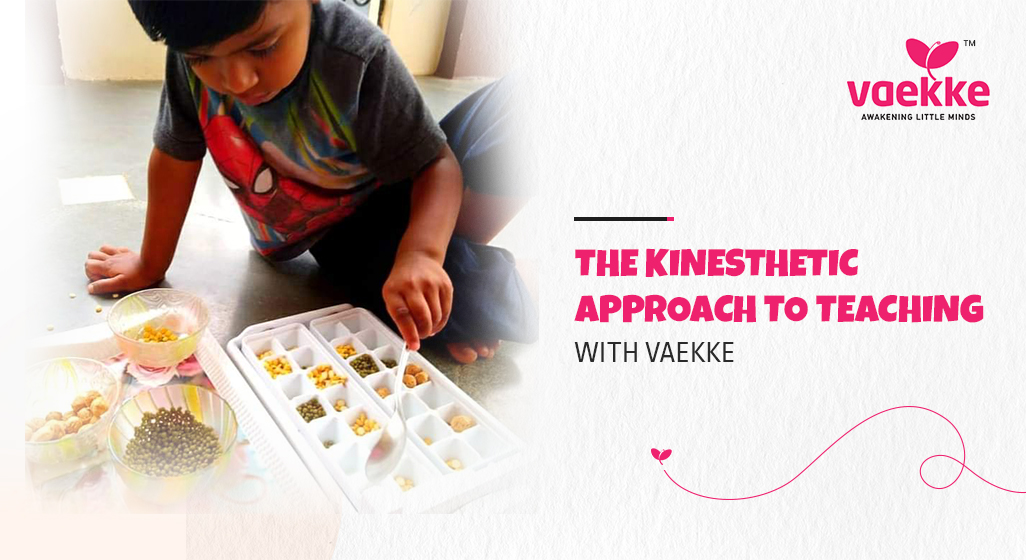Edu World !
The Vaekke EYFS blog

The Kinesthetic Approach to teaching with Vaekke
Are you looking for learning that promotes physical and mental development? The kinesthetic approach is a widely appreciated learning style that involves manipulation or physical objects to learn. It is a combination of audio and visual techniques that encourages multi-sensory learning.
What is Kinesthetic Approach?
The kinesthetic learning approach appeals to those who love to learn while involved in physical activities. The learners will engage better when their body is moving or is involved in any kind of physical activity. Once the body is busy doing an activity, they tend to process the inputs faster.
In most cases, children who are brought up in a Kinesthetic learning environment use the same methods in their real life. The effectiveness of this learning approach depends on the individual learners. Here are some of the benefits of the Kinesthetic learning approach –
- Increased information retention
- Enhanced muscle memory
- Increased engagement and participation
- Better risk assessment
- Problem-solving skills
- Improved self-confidence
- Strengthened emotional balance
Children learn in many ways and one of the best approaches is Kinesthetic learning. Toddlers and young children learn best when their body is engaged. Rather than simply listening to the lessons or doing homework, the children may not be able to grasp the subject. The kinesthetic learning approach is a great way to develop literacy in preschoolers and toddlers.
Kinesthetic Activities by Vaekke
Vaekke learning programs for pre-schoolers at home share some of the best activities for parents to do with their children.
- Alphabet post wall – This activity encourages the child to learn while playing with alphabets. Hand a long roll of paper with letters placed all over it. Give your child sticky notes with alphabets and ask him/her to place corresponding letters onto the hanging letters.
- Pop the names – Take a bubble wrap and write the name of your toddler on the back of the bubble wrap. Ask the child to pop the bubbles of each letter from his/her name.
- Build letters – Ask your child to collect random objects at home. Pick the first letter from the collected objects and ask the toddler to construct a word.
- Salt Tray – This is another activity that requires a rimmed cookie sheet, a printed mat (rainbow coloured), and a salt container. Place the mat on the tray and cover it with salt. Ask your child to draw on the salt using his/her fingers.
At Vaekke, we use a variety of activities and methods that Kinesthetic learners can use in different ways. If you want to teach your child at home, we advise the parents to create a comfortable environment where the child can move freely. Techniques such as mapping, drawing, writing are beneficial for young children for efficient absorption of the information. Creating activities that involve the use of different objects at home would be more efficient than listening to the instructor for an entire period without movement.
Besides, group activities are very helpful when learning. The kinesthetic approach encourages the parents to partner their children with their friends or siblings to make learning more effective. Parents can also brainstorm different activities based on the interests of their children.
Kinesthetic strategies to boost learning
Parents must know that Kinesthetic learners will be able to absorb more when they are taught in an environment that encourages physical movement. Some of the activities include – jumping rope, dancing, stretching, bouncing, etc.
Make sure to develop strong communication with your child to understand what works best for your child. Get involved in a child’s learning by explaining the final product. Outline the recommended steps and ask the child to follow the steps while learning. Visual learning is another important aspect of the Kinesthetic approach. Vaekke’s preschool learning program encourages the child to visualize the things they learn.
The bottom lines
Kinesthetic learning takes place by involving the young child in physical activities rather than listening to the lecture or reading books. Vaekke’s EQ-centric and device-free learning program works best for Kinesthetic learners interested in interactive activities. If you have a toddler who wants to get into everything, get in touch with us. We help your busy kid find their way to all those things he/she wants to explore. We provide you with all the hands-on learning opportunities to satisfy the curious mind of your child.
